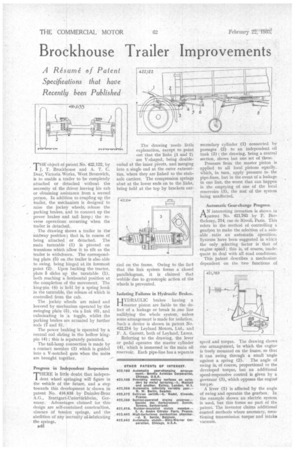Brockhouse Trailer mprovements
Page 66

If you've noticed an error in this article please click here to report it so we can fix it.
A Résumé of Patent Specifications that have Recently been Published
THE object of patent No. 422,122, by J. T. Brockhouse and A. T. G. Dear, Victoria Wbrks, West Bromwich, is to enable a trailer to be completely attached or detached without the necessity of the driver leaving his cab or obtaining assistance from a second person. In addition to coupling up the trailer, the mechanism is designed to raise the jockey wheels, release the parking brakes, and to connect up the power brakes and tail lamp ; the reverse operations occurring when the trailer is detached.
The drawing shows a trailer in the midway position ; that is, in course of being attached or detached. The main turntable (1) is pivoted on trunnions which allow it to tilt as the trailer is withdrawn. The corresponding plate (5) on the trailer is also able to swing, being hinged at its foremost point (2). Upon backing the tractor, plate 5 slides up the turntable (1), both reaching a horizontal position at the completion of the movement. The king-pin (4) is held by a spring hook in the turntable, the release of which is controlled from the cab.
The jockey Wheels are raised and lowered by mechanism operated by the swinging plate (5), via a link (6), and culminating in a toggle, whilst the parking brakes are actuated by further rods (7 and 8).
The power braking is operated by a central rod sliding in the hollow kingpin (4) ; this is sepgrately patented. The tail-lamp Connection is made by a contact member (3) which is guided into a V-notched gate when the units are brought together.
Progress in Independent Suspension
THERE is little doubt that independent wheel springing will figure in the vehicle of the future, and a step towards this development is shown in patent No. 416 635 by Daimler-Benz A . G. , Stuttgart-Un tert iirkh eim , Germany. Advantages claimed for this design are self-contained construCtion, absence of tension springs, and the abolition of any necessity of-lubricating the springs.
B48 The drawing needs little explanation, except to point out that the links (1 and 2) are V-shaped, being doubleended at the inner pivots, and merging into a. single end at the outer extremities, where they are linked to the stubaxle carriers. The compression springs abut at the lower ends on to the links, being held at the top by brackets car ried on the frame. Owing to the fact that the link system forms a closed parallelogram, it is claimed that wobble due to gyroscopic action of the wheels is prevented.
Isolating Failures in Hydraulic Brakes.
HYDRAULIC brakes having a 'master piston are liable to the defect of a leakage or break in one line nullifying the whole system, unless some arrangement is made for isolation. Such a device is shown in patent No. 422,214 by Leyland Motors, Ltd., and F. A. Garrett, both of Leyland, Lancs.
Referring to the drawing, the lever or pedal operates the master cylinder (4), which is immersed in the main oil reservoir. Each pipe-line has a separate secondary cylinder (1) connected by passages (2) to an independent oil tank (3) : the drawing, being a central section, shows but one set of these.
Pressure from the master piston is applied to all local pistons equally. Which, in turn, apply pressure to the pipe-lines, but in the event of a leakage in one line, the worst that can happen is the emptying .of one of the local reservoirs (3), the rest of the system being unaffected.
Automatic Gear-change Progress.
AN interesting invention is shown in patent No. 421,763 by P. Barthelemy, 214, rue de Rivoli, Paris. This refers to the method of controlling a gearbox to make the selection of a shit-. able • ratio an automatic operation. Systems have been suggested in which the only selecting factor is that of engine speed ; this is, of course, inadequate to deal with all read conditions.
This patent describes a mechanism dependent on the two functions of speed and torque. The drawing shows one arrangement, in which the engine is freely mounted on the frame, so that it can swing through a small angle against a spring (2). The angle of swing is, of course, proportional to the developed torque, but an additional speed-responsive control is given by a governor (3), which opposes the engine' torqae.
A lever (1) is affected by the angle of swing and operates the gearbox. In the example shown an electric system is used, but this forms no part of the patent. The inventor claims additional control methods where necessary, mentioning transmission torque and intake vacuum.




































































































